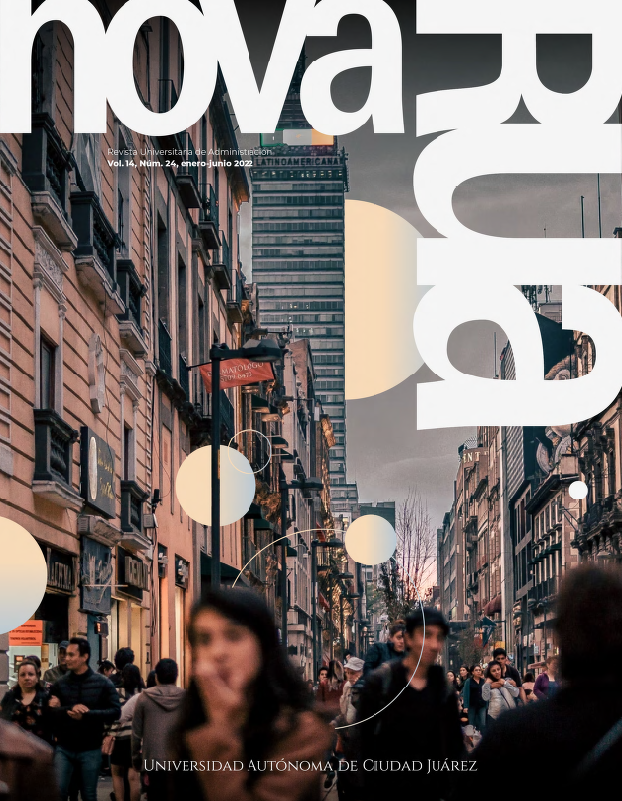The standard time and its importance in the quoting of manufacturing projects. A management approach
DOI:
https://doi.org/10.20983/novarua.2022.24.6Keywords:
Time study, Manufacturing systems, Harness manufacturing sectorAbstract
The adequate determination of labor cost of manufacturing projects is a decisive factor for the organizations’ competitiveness in this sector. This factor is priority in labor-intensive environments due to the emergence of new competitors. The objective of this work was to identify how nominal costs differ from real costs while quoting manufacturing projects in a harness manufacturing plant. This approach allowed to identify management alternatives to reduce these gaps. A set of relevant operations in terms of labor cost was chosen and the quoted labor cost was examined in relation to the real one, which was estimated by a time study. The results showed that labor cost estimates based on historical data differed significantly from those provided by the time studies. These results gave place to recognize management avenues. Conclusions derived from the study are presented, as well as recommendations for future work.
References
Arias, L., Portilla, L. y Fernández, S. (2010). La distribución de costos indirectos de fabricación, factor clave al costear productos. Scientia Et Technica, XVI(45), 79-84. Recuperado de: http://www.redalyc.org/articulo.oa?id=84917249014.
Casero, P. M. (2019). Estudio de métodos y tiempos en Lingotes Especiales S.A. (Tesis de pregrado). Universidad de Valladolid. Recuperado de: https://uvadoc.uva.es/handle/10324/40126.
de la Riva, J., González, M., Esquivel, R. y Alamillo, A. (2011). Desarrollo De Un Sistema De Capacitación Para La De Toma De Tiempos Estándar Mediante Cronómetro. Academia Journals, 3(1), 111-116. Recuperado de: https://drive.google.com/folderview?id=0B4GS5FQQLif9flRwUnZjOXV3SGtfdHB6RjNSTzFQSUR0ank3d2lMYU1MX19ja1VOdGFxd1k&usp=sharing.
Fiallos, R. D. (2015). Proceso De Ensamblaje De Aviones No Tripulados Para El Centro De Investigación y Desarrollo De La Fuerza Aérea Ecuatoriana (CIDFAE) (Tesis de Pregrado). Universidad Técnica de Ambato. Recuperado de: https://repositorio.uta.edu.ec/jspui/handle/123456789/19383.
Ganorkar, A. B., Lakhe, R. R. y Agrawal, K. N. (2019). Methodology for application of Maynard Operation Sequence Technique (MOST) for time-driven activity-based costing (TDABC). International Journal of Productivity and Performance Management, 68(1), 2-25. DOI: https://doi.org/10.1108/IJPPM-06-2017-0156.
Gozali, L., Daywin, F. J. y Jestinus, A. (2020). Calculation of labor amount with theory of constraints and line balancing method in Pt. XYZ Fish Crackers factory. IOP Conference Series: Materials Science and Engineering, 852(1), 1-8. DOI: https://doi.org/10.1088/1757-899X/852/1/012092.
Jayashree, S., Reza, M. N., Malarvizhi, C. A., Gunasekaran, A. y Rauf, M. A. (2022). Testing an adoption model for Industry 4.0 and sustainability: A Malaysian scenario. Sustainable Production and Consumption, 31, 313-330. DOI: https://doi.org/10.1016/j.spc.2022.02.015.
Linares, V. (2018). Diagnosis de averías y mantenimiento correctivo de sistemas de automatización industrial. IC Editorial.
Meyers, F. E. (2000). Estudio de tiempos y movimientos para la manufactura agil. Pearson Education.
Michalos, G., Fysikopoulos, A., Makris, S., Mourtzis, D. y Chryssolouris, G. (2015). Multi criteria assembly line design and configuration - An automotive case study. CIRP Journal of Manufacturing Science and Technology, 9, 69-87. DOI: https://doi.org/10.1016/j.cirpj.2015.01.002.
Miño, G., Moyano, J. y Santillán, C. (2019). Tiempos estándar para balanceo de línea en área soldadura del automóvil modelo cuatro. Ingeniería Industrial, 40(2), 110-122. Recuperado de: http://scielo.sld.cu/scielo.php?script=sci_arttext&pid=S1815-59362019000200110.
MTM (2022). MTM (Methods-Time Measurement). Recuperado de: https://mtm.org/en/about-mtm/mtm.
Niebel, B. W. y Freivalds, A. (2014). Ingeniería industrial : métodos, estándares y diseño del trabajo. Andris Freivald.
Puvanasvaran, A. P., Yap, Y. Y. y Yoong, S. S. (2019). Implementation of Maynard operation sequence technique in dry pack operation-a case study. ARPN Journal of Engineering and Applied Sciences, 14(21), 3732-3737. Recuperado de: http://www.arpnjournals.com/jeas/volume_21_2019.htm.
Roncancio, M., Reina, D., Hualpa, A., Felizzola, H. y Arango, C. (2017). Using learning curves and confidence intervals in a time study for the calculation of standard times. Inge Cuc, 13(2), 18-27. DOI: https://doi.org/10.17981/ingecuc.13.2.2017.02.
Rosa, E. S., Godina, R., Rodrigues, E. M. y Matias, J. C. (2022). An Industry 4.0 Conceptual Model Proposal for Cable Harness Testing Equipment Industry. Procedia Computer Science, 200, 1392-1401. DOI: https://doi.org/10.1016/j.procs.2022.01.340.
Sadeghitabar, F., Khan, S. A. y Eiliat, H. (2019). Cycle Time Reduction in the Plastic Fuel Tanks Production Line: A Lean Manufacturing Case Study at Kautex Corporation. International Conference on Industrial Engineering and Operations Management, 1518-1528.
Socconini, L. y Martín, J. P. (2019). Lean Energy 4.0. Guía de implementación. Alfaomega Marge Books.
Zandin, K. B. (2002). MOST Work Measurement Systems. Taylor & Francis. DOI: https://doi.org/10.1201/9781482275940.
Downloads
Published
Issue
Section
License
Copyright (c) 2022 Lorena Janeth Méndez Meléndez, Diego Adiel Sandoval Chávez, Luz Elena Terrazas Mata

This work is licensed under a Creative Commons Attribution-NonCommercial-ShareAlike 4.0 International License.
All contents of the electronic edition of the journal are distributed under a license and distribution "Creative Commons Attribution-Noncommercial-ShareAlike 4.0 International" (CC-BY-NC-SA). You can see from here the informative version of the license.
Those authors/publications as having this journal agree to the following terms:
a) Is allowed and recommends authors / as disseminate their work via the Internet (p. eg .: institutional telematic files or on their website), which can produce interesting exchanges and increase appointments of the published work. (See The Effect of Open Access).












